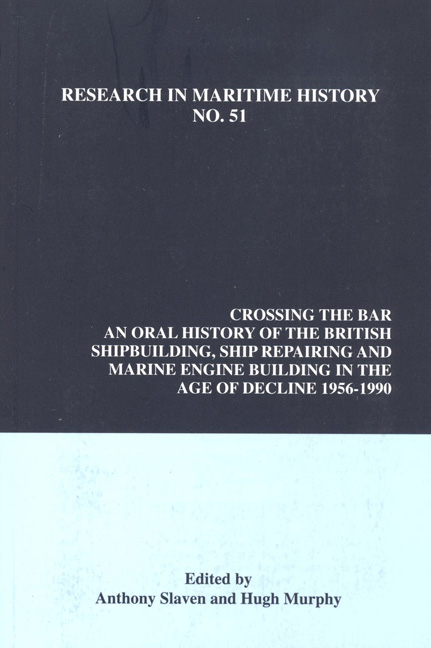 Crossing the Bar
Crossing the Bar Book contents
- Frontmatter
- Contents
- About the Authors
- Dedication
- Preface: A Shipbuilding Libretto
- Introduction
- Interviews
- Lower Clyde
- Upper Clyde
- The Tyne
- 16 G.H.R. Towers, John Redhead and Sons Ltd.
- 17 J.E. Steele, Swan Hunter, British Shipbuilders Plc
- 18 Peter Milne, Swan Hunter, British Shipbuilders Plc
- 19 P.D. Christie, Swan Hunter
- 20 James Jardine, Smith's Dock, Swan Hunter
- 21 Eric Crowdy, Hawthorn Leslie, George Clark NEM, William Doxford Engineers
- 22 M.F. Pyman, Mercantile Dry Dock Co. Ltd., Jarrow
- The Wear
- Barrow-in-Furness
- The South Coast
- The Humber
- Belfast
- British Shipbuilding Industry Officials
- The Trade Unions
- The Civil Servants, Board of Trade, Shipbuilding Enquiry Committee, Shipbuilding Industry Board, Ministry of Technology, Department of Trade and Industry, Department of Industry
- The Politicians
- Interviews British Shipbuilders Plc
- Conclusion
- Select Bibliography
19 - P.D. Christie, Swan Hunter
from The Tyne
- Frontmatter
- Contents
- About the Authors
- Dedication
- Preface: A Shipbuilding Libretto
- Introduction
- Interviews
- Lower Clyde
- Upper Clyde
- The Tyne
- 16 G.H.R. Towers, John Redhead and Sons Ltd.
- 17 J.E. Steele, Swan Hunter, British Shipbuilders Plc
- 18 Peter Milne, Swan Hunter, British Shipbuilders Plc
- 19 P.D. Christie, Swan Hunter
- 20 James Jardine, Smith's Dock, Swan Hunter
- 21 Eric Crowdy, Hawthorn Leslie, George Clark NEM, William Doxford Engineers
- 22 M.F. Pyman, Mercantile Dry Dock Co. Ltd., Jarrow
- The Wear
- Barrow-in-Furness
- The South Coast
- The Humber
- Belfast
- British Shipbuilding Industry Officials
- The Trade Unions
- The Civil Servants, Board of Trade, Shipbuilding Enquiry Committee, Shipbuilding Industry Board, Ministry of Technology, Department of Trade and Industry, Department of Industry
- The Politicians
- Interviews British Shipbuilders Plc
- Conclusion
- Select Bibliography
Summary
During the interwar period my father was Chairman of Swan Hunter and Wigham Richardson, so with this family background I had never wanted to do anything else but to become a shipbuilder. I went to Uppingham School, and when I finished there at the end of 1930, I went to Hawthorn Leslie as a pupil apprentice. I was moved across to the design room at the Neptune yard, and then became an improver for one and half years and spent that in the Estimating Office. During this time I went to Durham University to take a degree in naval architecture. I then went outside for experience as an assistant shipyard manager, before going on to take charge of the Design Office. During the war I became a Director of Swan Hunter and eventually ran the Neptune yard. In the late 1960s I was asked to inaugurate a training company to cover young apprentices, and eventually, adult training, foremen and management. I stayed there until I retired, just as British Shipbuilders took over. I was a founder member of the Shipbuilding Industry Training Board.
The great strength, and, in certain circumstances, the weakness of the industry in general was that it was made up of comparatively small firms. They were all run by individualists who knew quite well that the way that they built ships was the right and only way, and in many cases that was a great strength. The weakness there was that, excluding the war years, the shipbuilding industry had three good years and seven bad years. This meant that during the three good years you had to earn enough money to keep yourself going over the seven bad years. Some of the smaller units found that very difficult. This meant that you did not have all that money to spend on new equipment. You will find that where they did there were a number of firms who went to the wall because they had equipped their yard too well despite the fact that they could get work. When they came to settle their periods they were paying so much on the equipment that they eventually went to the wall.
- Type
- Chapter
- Information
- Crossing the BarAn Oral History of the British Shipbuilding, Ship Repairing and Marine Engine-Building Industries in the Age of Decline, 1956-1990, pp. 77 - 80Publisher: Liverpool University PressPrint publication year: 2013
